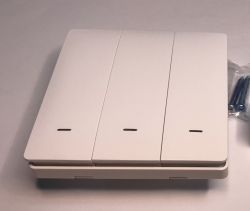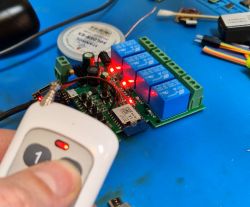FAQ
TL;DR: ESP‑12E/F fit compact WiFi relay builds: 4MB flash; “They have 4MB of flash.” Wemos D1 mini adds microUSB power/programming; avoid ESP‑01 for limited GPIO. [Elektroda, rafels, post #17814043]
Why it matters: Makers choosing an ESP to drive a relay need small size, enough flash, and easy programming.
Quick Facts
- ESP‑12E/F: 4MB flash; bare modules need regulated power and an external programmer. [Elektroda, rafels, post #17814043]
- Wemos D1 mini: microUSB power/programming; only slightly larger than bare modules. [Elektroda, rafels, post #17814043]
- Add a transistor driver between GPIO and relay input for reliable switching. [Elektroda, rafels, post #17814096]
- Ready‑made WiFi relay boards using ESP‑01S are available. [Elektroda, khoam, post #17814583]
- ESP8266 Arduino core and libraries are on GitHub; setup guide linked. [Elektroda, rafels, post #17814964]
What’s the best ESP board for a compact WiFi relay module?
ESP‑12E/F suits minimal builds with 4MB flash and small footprint. Wemos D1 mini adds microUSB power and programming, easing prototyping. Avoid ESP‑01 for its limited GPIO and smaller flash. “I recommend the Wemos D1 mini.” [Elektroda, rafels, post #17814043]
Is there an ESP board like an Arduino Pro Mini, but with WiFi?
Yes. Wemos D1 mini behaves like a tiny dev board with onboard USB. It is only slightly larger than bare ESP‑12 modules. It simplifies wiring and flashing and fits tight enclosures. It is a practical Pro‑Mini‑with‑WiFi choice. [Elektroda, rafels, post #17814043]
Can I drive a relay directly from an ESP8266/ESP32 GPIO pin?
Use a transistor between the GPIO and the relay input. With NodeMCU firmware, relay control needs “a few dozen lines of Lua.” Directly powering a relay from a pin is not advised. The transistor protects the MCU and ensures reliable switching. [Elektroda, rafels, post #17814096]
Are there ready‑made WiFi relay boards using ESP8266?
Yes. Ready‑made relay modules exist that use an ESP‑01S for WiFi control. They offer a compact path to a networked relay. These boards are useful as remote, WiFi‑addressable relay endpoints. [Elektroda, khoam, post #17814583]
How do I program an ESP‑01/ESP‑01S on a relay board?
Remove the ESP‑01 from the relay module and place it in an ESP‑01 USB programmer. Flash your firmware, then reinstall the module. This approach works because the ESP‑01 is removable on those boards. [Elektroda, khoam, post #17814627]
How do I flash an ESP‑01S for a WiFi relay?
- Extract the ESP‑01/ESP‑01S from the relay board and insert it in a suitable programmer.
- Upload your firmware through the programmer.
- Reinstall the module on the relay board and test switching. [Elektroda, khoam, post #17814627]
Can I avoid coding and still control relays over WiFi?
Yes. You can flash a ready firmware to the ESP8266 and configure it. The thread suggests using the EasyESP firmware to avoid writing code. This path fits quick proofs of concept or non‑programmers. You trade flexibility for speed of setup. [Elektroda, rafels, post #17814861]
Where do I get ESP8266 support for Arduino IDE?
Install the ESP8266 Arduino core and libraries from the official GitHub repository. The linked post also includes a beginner tutorial. After installation, select an ESP8266 board and compile sketches. This is the standard Arduino‑style workflow for ESP8266. [Elektroda, rafels, post #17814964]
Do Arduino AVR libraries work unchanged on ESP8266?
No. “There is a completely different set of libraries for ESP.” Only the Arduino IDE editor is the same. Plan to use ESP‑specific or compatible libraries. Test code, as some AVR‑only libraries will not compile. [Elektroda, rafels, post #17814925]
Is the ESP‑01 too limited for a relay project?
It works, but expansion is constrained. ESP‑01 variants can have 512kB flash and very few GPIOs. That limits future features and OTA updates. The base system consumes much of that flash. Choose ESP‑12E/F or D1 mini for 4MB and flexibility. [Elektroda, rafels, post #17814043]
How should I link an ESP32 master to an ESP8266 relay node?
Give the ESP8266 a simple HTTP or TCP server that exposes relay endpoints. Have the ESP32 call those endpoints over WiFi. The Arduino core provides client and server examples to implement this pattern. [esp8266/Arduino]
Do I need an extra AVR microcontroller next to an ESP8266?
No. Use the ESP8266 alone for relay control and WiFi. If desired, you can attach an additional AVR to the 32‑bit MCU. Most projects do not require the extra chip, keeping designs simpler. [Elektroda, rafels, post #17814096]
How many GPIOs should I plan for when choosing a module?
Plan module choice around your GPIO needs. If you foresee adding features, pick modules with more pins. Evaluate options from the GPIO side to avoid redesigns later. [Elektroda, rafels, post #17814043]







